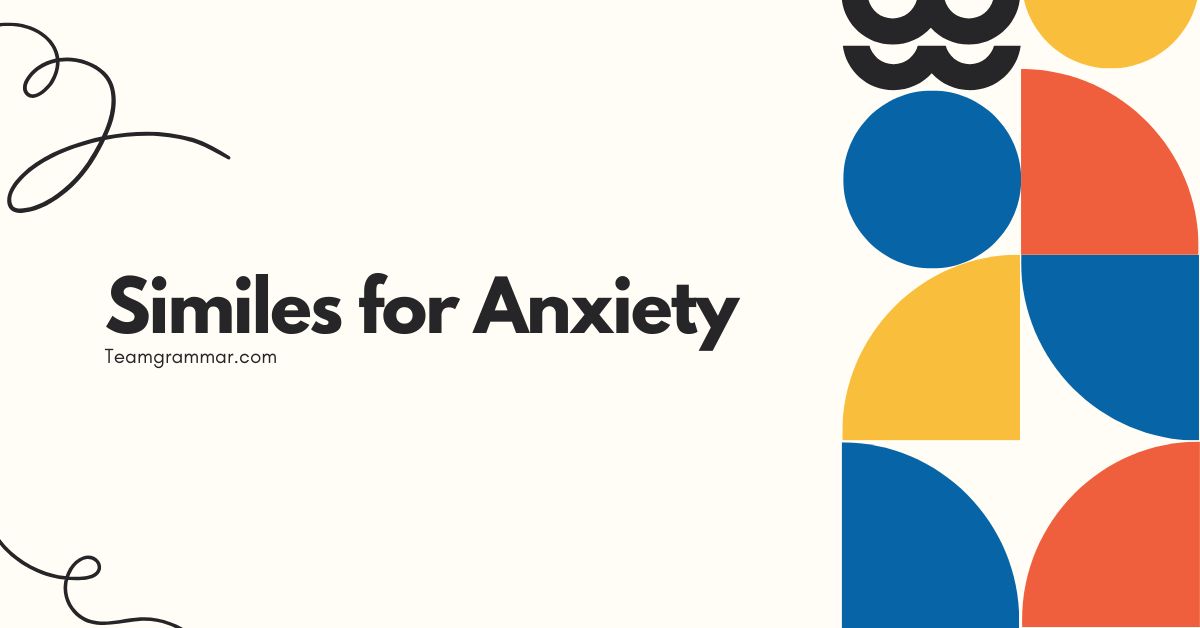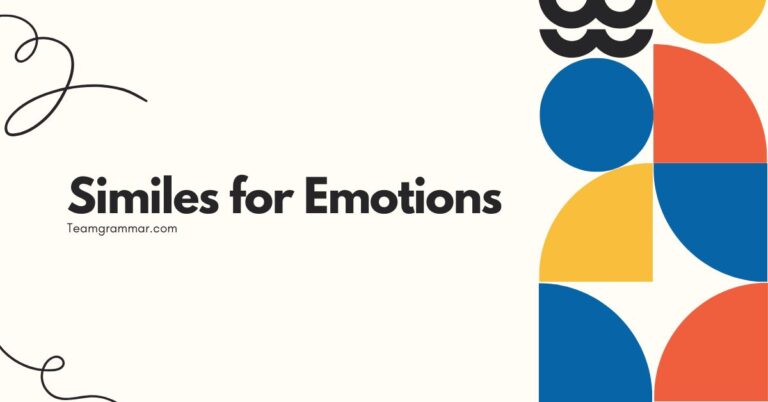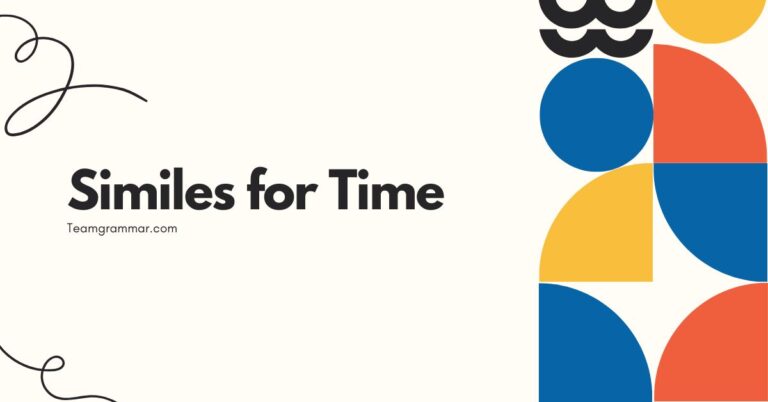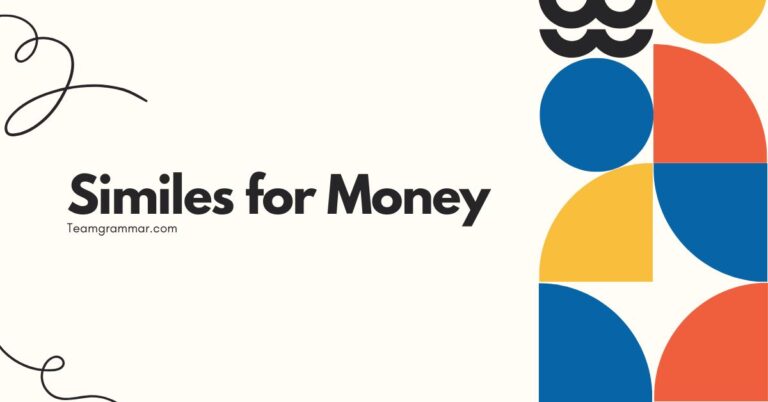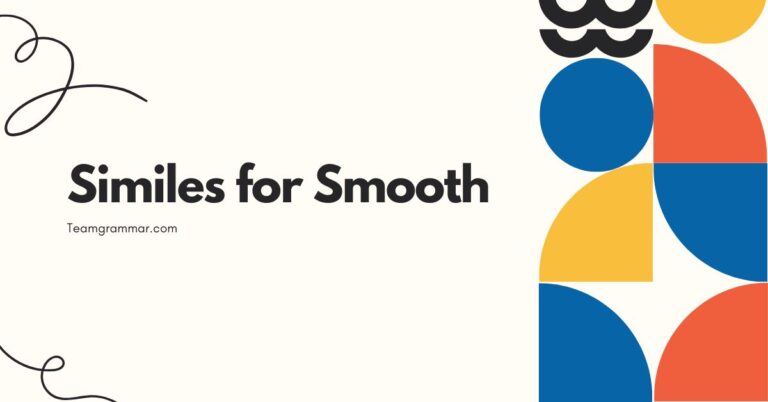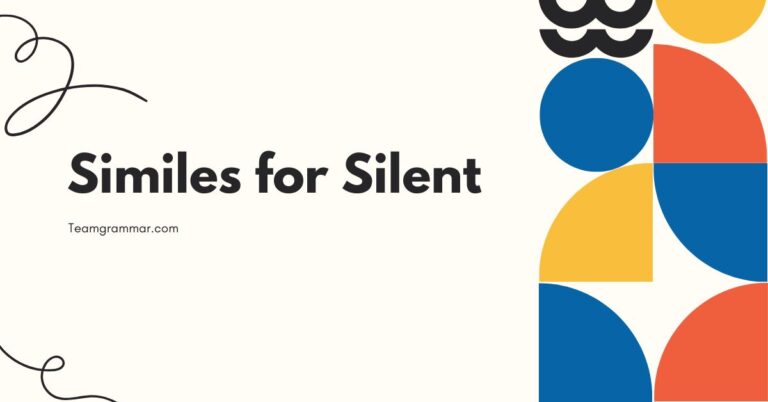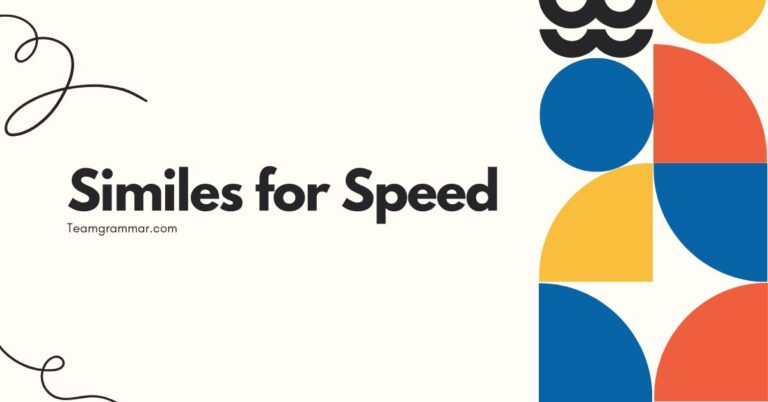29 Similes for Anxiety: A Grammatical Guide
Anxiety is a prevalent emotion, and being able to express it effectively is crucial. Similes offer a powerful way to articulate the often overwhelming and complex feelings associated with anxiety.
This article delves into the grammatical structure and usage of similes specifically tailored to describe anxiety, providing a comprehensive guide for mastering this literary device. Understanding and utilizing these similes can enrich your writing, enhance your communication, and offer a more nuanced portrayal of emotional experiences.
This guide benefits students, writers, and anyone looking to improve their descriptive language skills.
Whether you’re crafting compelling narratives, engaging in therapeutic writing, or simply aiming to articulate your feelings more precisely, this resource will equip you with the knowledge and tools to use similes effectively. By exploring the nuances of simile construction and providing ample examples, this article aims to demystify the process and empower you to express anxiety with greater clarity and impact.
Table of Contents
- Definition of Similes
- Structural Breakdown of Similes
- Types of Similes for Anxiety
- Examples of Similes for Anxiety
- Usage Rules for Similes
- Common Mistakes with Similes
- Practice Exercises
- Advanced Topics in Simile Usage
- Frequently Asked Questions
- Conclusion
Definition of Similes
A simile is a figure of speech that directly compares two different things using the words “like” or “as.” Its primary function is to create a vivid and relatable image or understanding by associating an unfamiliar concept with something familiar. In the context of anxiety, similes can help articulate the abstract and often overwhelming sensations by likening them to tangible, relatable experiences.
This makes the feeling of anxiety more accessible and understandable to both the person experiencing it and those around them.
Similes fall under the broader category of figurative language, which also includes metaphors, personification, and hyperbole. Unlike metaphors, which assert that one thing *is* another, similes only suggest a resemblance.
This distinction is crucial, as it allows for a more nuanced and less definitive comparison, often better suited to describing the subjective experience of anxiety. The use of “like” or “as” signals the comparative nature of the statement.
The effectiveness of a simile lies in its ability to create a strong mental image and evoke a particular emotion or understanding. By carefully selecting the objects or experiences being compared, writers can convey the intensity, nature, and impact of anxiety in a way that resonates with the audience.
The choice of comparison should be both accurate and evocative, capturing the essence of the feeling being described.
Structural Breakdown of Similes
The basic structure of a simile involves three key components: the subject (the thing being described, in this case, anxiety), the linking word (either “like” or “as”), and the object of comparison (the thing to which anxiety is being compared). Understanding this structure is essential for constructing effective and grammatically correct similes.
The subject is the focal point of the simile and represents the feeling, sensation, or experience of anxiety. For instance, “My anxiety” or “The feeling of dread” could serve as the subject.
The linking word, “like” or “as,” acts as the bridge connecting the subject to the object of comparison. It signals that a similarity is being drawn, rather than an equivalence.
The object of comparison is the element that provides a relatable or understandable context for the subject. It should be something that the audience can easily visualize or comprehend.
For example, comparing anxiety to “a swarm of bees” or “a tightening knot” helps to create a concrete image of the abstract feeling. The effectiveness of the simile depends on the clarity and relevance of this comparison.
Here are a few examples illustrating the structural breakdown:
- Subject: My anxiety Linking Word: is like Object of Comparison: a runaway train.
- Subject: Her fear Linking Word: was as Object of Comparison: cold as ice.
- Subject: The panic Linking Word: felt like Object of Comparison: drowning in quicksand.
By mastering this structural framework, you can create similes that are both grammatically sound and emotionally resonant, effectively conveying the complex nature of anxiety.
Types of Similes for Anxiety
Similes for anxiety can be categorized based on the specific aspect of anxiety they aim to describe. These categories can include similes that focus on the physical sensations, the emotional impact, the cognitive distortions, and the behavioral manifestations of anxiety.
By understanding these different types, you can choose the most appropriate simile to convey the specific nuance you want to express.
Similes Describing Physical Sensations
These similes focus on the physical symptoms of anxiety, such as a racing heart, shortness of breath, or muscle tension. They help to convey the tangible discomfort that anxiety can cause.
Examples include: “My chest felt like it was being crushed by a weight” or “My heart was pounding like a drum.”
Similes Describing Emotional Impact
These similes capture the emotional toll of anxiety, such as feelings of fear, dread, or helplessness. They help to convey the psychological burden of anxiety.
Examples include: “My mind felt like a battlefield” or “I felt as vulnerable as a newborn.”
Similes Describing Cognitive Distortions
These similes illustrate the distorted thinking patterns associated with anxiety, such as catastrophizing or overgeneralization. They help to convey the irrationality of anxious thoughts.
Examples include: “My thoughts were racing like a broken record” or “My worries felt as big as mountains.”
Similes Describing Behavioral Manifestations
These similes describe the behavioral responses to anxiety, such as avoidance, restlessness, or hypervigilance. They help to convey the impact of anxiety on daily life.
Examples include: “I felt like a prisoner in my own home” or “I was as jumpy as a cat on a hot tin roof.”
Examples of Similes for Anxiety
The following sections provide extensive examples of similes used to describe various types and aspects of anxiety. These examples are categorized to help you understand how similes can be tailored to specific contexts.
General Anxiety
General anxiety often manifests as a pervasive sense of worry and unease. The similes in this section aim to capture that feeling of constant apprehension and restlessness.
The table below presents several examples:
| Simile | Explanation |
|---|---|
| My anxiety is like a persistent hum in the background. | Describes the constant, nagging presence of anxiety. |
| The worry clung to me like a second skin. | Illustrates how anxiety can feel inseparable from oneself. |
| My thoughts spun like a carousel out of control. | Conveys the feeling of racing, uncontrollable thoughts. |
| Fear gripped me like a vise. | Emphasizes the intense, constricting nature of anxiety. |
| I felt as though I was walking on eggshells. | Captures the sense of constant vigilance and fear of making a mistake. |
| My mind was like a tangled ball of yarn. | Illustrates the confusion and disorganization caused by anxiety. |
| Anxiety shadowed me like a dark cloud. | Depicts the ever-present, looming feeling of dread. |
| The pressure mounted like a rising tide. | Conveys the gradual build-up of anxiety and stress. |
| I felt as restless as a caged bird. | Illustrates the inability to relax and find peace. |
| My stomach churned like a washing machine. | Describes the physical discomfort associated with anxiety. |
| The uncertainty hung in the air like a thick fog. | Captures the feeling of being disoriented and unsure. |
| I felt as though I was drowning in a sea of worries. | Emphasizes the overwhelming nature of anxiety. |
| My anxiety felt like a heavy weight on my chest. | Illustrates the physical burden of carrying anxiety. |
| The fear spread through me like wildfire. | Depicts the rapid and uncontrollable spread of anxiety. |
| My mind raced like a hamster on a wheel. | Conveys the feeling of being stuck in a cycle of anxious thoughts. |
| I felt as though I was trapped in a maze with no exit. | Illustrates the feeling of being lost and overwhelmed by anxiety. |
| My anxiety was like a monster lurking in the shadows. | Depicts the constant fear and anticipation of something bad happening. |
| The tension built up like a coiled spring. | Conveys the feeling of being on edge and ready to snap. |
| I felt as vulnerable as a turtle without its shell. | Illustrates the feeling of being exposed and unprotected. |
| My thoughts were like bees buzzing around my head. | Describes the irritating and distracting nature of anxious thoughts. |
| The anxiety gnawed at me like a persistent hunger. | Conveys the feeling of being constantly consumed by worry. |
| I felt as though I was walking a tightrope. | Illustrates the feeling of being constantly on edge and needing to maintain balance. |
| My anxiety was like a broken record, repeating the same fears. | Depicts the repetitive and intrusive nature of anxious thoughts. |
| The fear paralyzed me like a deer in headlights. | Conveys the feeling of being unable to act or think clearly due to anxiety. |
Social Anxiety
Social anxiety revolves around fear of judgment and negative evaluation in social situations. These similes capture the feeling of being scrutinized and the desire to avoid social interactions.
The table below provides examples:
| Simile | Explanation |
|---|---|
| Talking to strangers felt like walking through a minefield. | Illustrates the feeling of constant danger and potential for embarrassment. |
| Being in a crowd felt like being trapped in a suffocating box. | Conveys the feeling of being overwhelmed and claustrophobic in social situations. |
| My voice trembled like a leaf in the wind. | Describes the physical manifestation of anxiety when speaking in public. |
| I felt as though everyone’s eyes were lasers, focused on my flaws. | Illustrates the feeling of being intensely scrutinized. |
| My face flushed like a tomato. | Describes the physical manifestation of embarrassment and anxiety. |
| Social gatherings felt like a performance, and I was always off-script. | Conveys the feeling of needing to perform perfectly in social situations. |
| I felt as awkward as a newborn giraffe trying to walk. | Illustrates the feeling of being clumsy and out of place. |
| My heart pounded like a drum solo before speaking in public. | Describes the intense physical anxiety experienced before social interactions. |
| The fear of judgment hung over me like a guillotine. | Conveys the feeling of impending doom and negative evaluation. |
| I felt as though I was under a spotlight, every move magnified. | Illustrates the feeling of being constantly watched and judged. |
| My mind went blank like a chalkboard when trying to make conversation. | Describes the inability to think clearly or find the right words in social situations. |
| I felt as isolated as an island in a sea of people. | Illustrates the feeling of loneliness and disconnection in social settings. |
| My hands were as clammy as a fish. | Describes the physical manifestation of anxiety, such as sweaty palms. |
| Making eye contact felt like staring into the sun. | Conveys the discomfort and intensity of social interaction. |
| I felt as though I was wearing a mask, hiding my true self. | Illustrates the feeling of needing to conceal one’s true feelings and thoughts. |
| My words felt as heavy as lead when trying to speak. | Describes the difficulty of expressing oneself in social situations. |
| I felt as though I was walking on a stage, with an audience judging every step. | Conveys the feeling of being constantly evaluated and scrutinized. |
| My anxiety was like a wall, separating me from others. | Illustrates the feeling of being disconnected and unable to form meaningful connections. |
| I felt as though I was invisible, yet still being judged. | Conveys the paradoxical feeling of being unnoticed yet still scrutinized. |
| Social situations felt like a test I was destined to fail. | Illustrates the feeling of inadequacy and fear of negative outcomes. |
| My thoughts raced like a runaway train, predicting social disasters. | Describes the racing, negative thoughts associated with social anxiety. |
| I felt as shaky as a newborn fawn in social settings. | Conveys the feeling of instability and vulnerability. |
| My attempts at conversation were as awkward as a square peg in a round hole. | Illustrates the difficulty of fitting in and connecting with others. |
| I felt as though I was walking through a funhouse mirror, seeing only my flaws. | Depicts the distorted self-perception and focus on imperfections. |
Panic Attacks
Panic attacks are characterized by sudden, intense fear accompanied by physical symptoms. These similes aim to capture the overwhelming and terrifying nature of these episodes.
The table below illustrates various examples:
| Simile | Explanation |
|---|---|
| The panic hit me like a tidal wave. | Describes the sudden and overwhelming nature of a panic attack. |
| My heart raced like a hummingbird’s wings. | Illustrates the rapid heartbeat associated with panic. |
| I felt as though I was suffocating, like being buried alive. | Conveys the feeling of shortness of breath and impending doom. |
| The world spun around me like a dizzying carnival ride. | Describes the feeling of disorientation and loss of control. |
| My chest felt like it was being crushed by an elephant. | Illustrates the intense pressure and pain in the chest. |
| I felt as though I was having a heart attack. | Conveys the intense fear and physical symptoms that mimic a heart attack. |
| My body trembled like an earthquake. | Describes the uncontrollable shaking and tremors. |
| I felt as though I was losing my mind. | Conveys the feeling of detachment from reality and loss of control. |
| The fear was as sharp as a knife. | Illustrates the intense and piercing nature of the fear. |
| I felt as though I was trapped in a nightmare. | Conveys the feeling of being helpless and terrified. |
| My vision blurred like looking through a distorted lens. | Describes the visual disturbances associated with panic. |
| I felt as though I was going to die. | Conveys the intense fear of death during a panic attack. |
| My breathing was as shallow as a fish out of water. | Describes the difficulty breathing and feeling of suffocation. |
| I felt as though I was floating outside my body. | Conveys the feeling of detachment and derealization. |
| The panic surged through me like an electric shock. | Illustrates the sudden and intense feeling of fear. |
| My thoughts scattered like leaves in the wind. | Describes the disorganized and racing thoughts. |
| I felt as though I was drowning in a sea of fear. | Conveys the overwhelming and suffocating nature of panic. |
| My body was as tense as a tightly wound spring. | Describes the physical tension and rigidity. |
| I felt as though I was trapped in a horror movie. | Conveys the feeling of being helpless and terrified in a frightening situation. |
| The panic attack was like a sudden storm, leaving me exhausted. | Illustrates the sudden onset and draining aftermath of a panic attack. |
Performance Anxiety
Performance anxiety is the fear of failing or being negatively evaluated during a performance. These similes capture the feeling of pressure and the fear of making mistakes.
The table below presents various examples:
| Simile | Explanation |
|---|---|
| Stepping on stage felt like walking the plank. | Illustrates the feeling of impending doom and high stakes. |
| My hands were as slippery as eels before the presentation. | Describes the physical manifestation of anxiety, such as sweaty palms. |
| I felt as though all eyes were magnifying glasses, scrutinizing every detail. | Conveys the feeling of being intensely observed and judged. |
| My mind went blank like a computer screen crashing. | Describes the inability to think clearly or remember information. |
| My voice cracked like a teenager going through puberty. | Illustrates the physical manifestation of anxiety, such as a trembling voice. |
| The pressure mounted like a stack of bricks on my chest. | Conveys the feeling of being weighed down by expectations. |
| I felt as though I was walking a tightrope without a safety net. | Illustrates the feeling of being exposed and vulnerable. |
| My legs felt like jelly beneath me. | Describes the physical manifestation of anxiety, such as weak legs. |
| The fear of failure loomed over me like a dark shadow. | Conveys the feeling of impending doom and negative consequences. |
| I felt as though I was being judged by a panel of experts. | Illustrates the feeling of being evaluated and scrutinized. |
| My heart pounded like a drum solo before the audition. | Describes the intense physical anxiety experienced before performing. |
| The stage felt like a battlefield, and I was going into combat. | Conveys the feeling of high stakes and intense pressure. |
| I felt as though I was performing under a microscope. | Illustrates the feeling of being intensely scrutinized and evaluated. |
| My memory was like a sieve, letting all the information slip through. | Describes the inability to recall information due to anxiety. |
| I felt as though I was being graded on every word and gesture. | Conveys the feeling of constant evaluation and judgment. |
| The audience’s silence was as deafening as an explosion. | Illustrates the intense pressure and anxiety created by the audience’s anticipation. |
| My confidence crumbled like a sandcastle in the tide. | Describes the rapid loss of self-assurance and belief in one’s abilities. |
| I felt as though I was performing for my life. | Conveys the feeling of high stakes and the importance of success. |
| The fear of messing up was like a constant whisper in my ear. | Illustrates the persistent and intrusive nature of anxious thoughts. |
| My movements felt as robotic as a wind-up toy. | Describes the stiff and unnatural movements caused by anxiety. |
Health Anxiety
Health anxiety is characterized by excessive worry about one’s health and the fear of having a serious illness. These similes capture the feeling of being constantly vigilant and the fear of physical symptoms.
The table below provides examples:
| Simile | Explanation |
|---|---|
| Every ache felt like the beginning of a terminal illness. | Illustrates the tendency to catastrophize and interpret normal sensations as serious symptoms. |
| My body felt like a ticking time bomb. | Conveys the feeling of impending doom and the fear of a sudden health crisis. |
| I felt as though my body was betraying me. | Illustrates the feeling of distrust and anxiety about one’s physical health. |
| My mind was like a search engine, constantly looking for symptoms. | Describes the obsessive preoccupation with health-related information. |
| Every symptom felt like a confirmation of my worst fears. | Conveys the tendency to interpret ambiguous signs as evidence of serious illness. |
| The uncertainty about my health hung over me like a dark cloud. | Illustrates the constant worry and anxiety about potential health problems. |
| I felt as though I was living in a medical drama. | Conveys the feeling of being constantly focused on health-related issues and potential crises. |
| My anxiety was like a magnifying glass, making every sensation seem significant. | Describes the tendency to amplify and overinterpret normal bodily sensations. |
| The fear of illness was like a constant companion. | Illustrates the persistent and intrusive nature of health anxiety. |
| I felt as though I was waiting for the other shoe to drop. | Conveys the feeling of impending doom and the anticipation of a negative health diagnosis. |
| My body felt like a puzzle, and I was constantly trying to find the missing piece. | Describes the obsessive focus on understanding and diagnosing one’s health. |
| I felt as though I was trapped in a loop of endless doctor’s appointments. | Conveys the feeling of being consumed by medical consultations and tests. |
| My thoughts were like a broken record, repeating the same health concerns. | Illustrates the repetitive and intrusive nature of anxious thoughts about health. |
| I felt as though I was living on borrowed time. | Conveys the feeling of fragility and the fear of a sudden health decline. |
| My health anxiety was like a shadow, always lurking in the background. | Illustrates the constant presence and influence of health-related worries. |
Usage Rules for Similes
While similes offer creative freedom, some rules ensure clarity and effectiveness. The comparison should be logical and understandable. Avoid comparing things that have no discernible similarity, as this can lead to confusion. A good simile should create a clear and vivid image in the reader’s mind.
Maintain consistency within the comparison.Ensure that the aspects being compared are relevant and aligned. For instance, if you’re comparing the intensity of anxiety to the heat of a fire, focus on the aspect of intensity rather than other characteristics of fire.Avoid clichés.Overused similes like “as busy as a bee” or “as strong as an ox” can diminish the impact of your writing.
Strive for originality and fresh comparisons that capture the unique nuances of anxiety.Consider your audience.The effectiveness of a simile depends on the audience’s ability to understand and relate to the comparison. Choose objects of comparison that are familiar and meaningful to your target audience.
Ensure grammatical correctness.The simile should be grammatically sound. This includes using the correct form of “like” or “as” and ensuring that the sentence structure is clear and concise.Use similes sparingly.Overusing similes can detract from the overall impact of your writing.
Use them strategically to emphasize key points and create vivid imagery, but avoid overwhelming the reader with too many comparisons.
Common Mistakes with Similes
Several common mistakes can undermine the effectiveness of similes. One frequent error isusing metaphors instead of similes.
Remember that similes use “like” or “as” to draw a comparison, while metaphors directly equate two things. For example:
- Incorrect (Metaphor): Anxiety is a monster.
- Correct (Simile): Anxiety is like a monster lurking in the shadows.
Another common mistake iscreating illogical or unclear comparisons. The object of comparison should be something that is readily understandable and relatable to the reader.
For example:
- Incorrect: Anxiety is like a quantum entanglement.
- Correct: Anxiety is like a tangled ball of yarn.
Using clichésis another pitfall to avoid. Overused similes lack originality and can make your writing seem uninspired.
For example:
- Incorrect: My anxiety was as clear as day.
- Correct: My anxiety was as transparent as glass, revealing my deepest fears.
Finally, grammatical errors can weaken the impact of your simile. Ensure that your sentence structure is correct and that you are using the appropriate form of “like” or “as.” For example:
- Incorrect: Anxiety is feel like a weight.
- Correct: Anxiety feels like a weight on my chest.
Practice Exercises
Test your understanding of similes with the following exercises. Create similes for anxiety based on the prompts provided.
Exercise 1: Complete the Simile
| Question | Answer |
|---|---|
| 1. My anxiety is like _____. | 1. My anxiety is like a runaway train, speeding towards disaster. |
| 2. Her fear was as _____ as _____. | 2. Her fear was as cold as ice, chilling her to the bone. |
| 3. The panic felt like _____. | 3. The panic felt like drowning in quicksand, pulling her under. |
| 4. Social anxiety is like _____. | 4. Social anxiety is like walking through a minefield, waiting for an explosion. |
| 5. Performance anxiety feels as _____ as _____. | 5. Performance anxiety feels as heavy as a lead weight, dragging me down. |
| 6. Health anxiety is like _____. | 6. Health anxiety is like a magnifying glass, exaggerating every sensation. |
| 7. The feeling of dread was as _____ as _____. | 7. The feeling of dread was as thick as fog, obscuring my vision. |
| 8. My thoughts raced like _____. | 8. My thoughts raced like a flock of birds, scattering in all directions. |
| 9. The tension built up like _____. | 9. The tension built up like a coiled spring, ready to snap. |
| 10. I felt as vulnerable as _____. | 10. I felt as vulnerable as a newborn, exposed to the world. |
Exercise 2: Rewrite the Sentence as a Simile
| Question | Answer |
|---|---|
| 1. My anxiety is overwhelming. | 1. My anxiety is like a tidal wave, threatening to engulf me. |
| 2. She was paralyzed by fear. | 2. She was as paralyzed as a deer caught in headlights. |
| 3. The panic attack was sudden and intense. | 3. The panic attack hit like a lightning bolt, sudden and intense. |
| 4. Social situations make me uncomfortable. | 4. Social situations feel like walking on eggshells, always cautious. |
| 5. He felt pressured to perform perfectly. | 5. He felt as pressured as a diamond in the making, needing to be flawless. |
| 6. She worried excessively about her health. | 6. She worried about her health like a mother hen, constantly vigilant. |
| 7. The uncertainty made me uneasy. | 7. The uncertainty felt like a loose thread, unraveling my peace of mind. |
| 8. My thoughts were chaotic and disorganized. | 8. My thoughts were like a tangled web, chaotic and disorganized. |
| 9. The anticipation was unbearable. | 9. The anticipation was as unbearable as a stretched rubber band, ready to break. |
| 10. I felt exposed and defenseless. | 10. I felt as exposed and defenseless as a soldier without armor. |
Exercise 3: Identify the Type of Anxiety Described by the Simile
| Question | Answer |
|---|---|
| 1. My heart raced like a hummingbird’s wings. | 1. Panic Attack |
| 2. Talking to strangers felt like walking through a minefield. | 2. Social Anxiety |
| 3. Every ache felt like the beginning of a terminal illness. | 3. Health Anxiety |
| 4. Stepping on stage felt like walking the plank. | 4. Performance Anxiety |
| 5. The worry clung to me like a second skin. | 5. General Anxiety |
| 6. My voice trembled like a leaf in the wind. | 6. Social Anxiety |
| 7. The world spun around me like a dizzying carnival ride. | 7. Panic Attack |
| 8. The pressure mounted like a stack of bricks on my chest. | 8. Performance Anxiety |
| 9. Anxiety shadowed me like a dark cloud. | 9. General Anxiety |
| 10. I felt as though my body was betraying me. | 10. Health Anxiety |
Advanced Topics in Simile Usage
For advanced learners, exploring more nuanced aspects of simile usage can further enhance your writing. This includes understanding the use ofextended similes, which involve developing a comparison over several sentences or paragraphs, creating a more elaborate and impactful image.
For instance, instead of simply stating, “Anxiety is like a storm,” you could elaborate:
“Anxiety is like a storm, brewing slowly at first, with only a few dark clouds gathering on the horizon. As it approaches, the wind picks up, and the rain begins to fall, harder and harder, until it becomes a torrential downpour.
The thunder rolls, and the lightning flashes, each strike bringing a new wave of fear and uncertainty. When the storm finally passes, it leaves behind a trail of destruction, leaving you exhausted and shaken.”
Another advanced technique is the use ofironic similes, which create a contrast between what is being said and what is actually meant. This can be a powerful tool for conveying complex emotions or creating a sense of unease.
For example, saying “I felt as calm as a hurricane” when actually experiencing intense anxiety can highlight the disjunction between external appearances and internal turmoil.
Furthermore, consider the use of sensory details in your similes to create a more immersive experience for the reader. Instead of simply stating, “My anxiety was like a weight,” you could add sensory details: “My anxiety was like a heavy, suffocating weight, pressing down on my chest and making it hard to breathe.” This
Frequently Asked Questions
Conclusion
Mastering the art of using similes to describe anxiety can significantly enhance your ability to communicate complex emotions and experiences. By understanding the structural components, types, and usage rules of similes, you can craft vivid and impactful comparisons that resonate with your audience.
Avoid common mistakes, practice regularly, and explore advanced techniques to further refine your skills. Whether you’re a student, writer, or simply someone seeking to articulate your feelings more effectively, the power of similes can unlock new levels of expression and understanding in the realm of anxiety.

